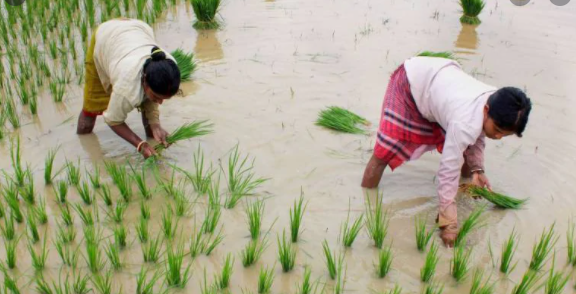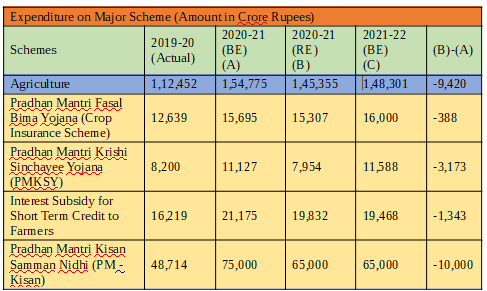Union Budget 2021-22 Shows a Drop in Expenditure on Agricultural Schemes

Representational Image. Image Courtesy: Moneycontrol
Commenting on a Budget presented amid the farmers’ agitation rocking the country, Prime Minister Narendra Modi said that farmers and villages are at the ‘heart of this year’s Budget’. He added, “The Budget focuses on increasing farmers' income, several measures have been taken in this direction. Farmers will be able to get loans easily. Provisions have been made to strengthen APMC (Agricultural Produce Market Committee) markets with the help of Agriculture Infrastructure Fund.” However, neither Prime Minister Modi nor Finance Minister Nirmala Sitharaman mentioned the budget allocations for the agricultural sector in Union Budget 2021-22.
The allocation made for Agriculture and Allied Activities for this year stood at Rs. 1,48,301 crore. This accounts for 4% of the central government’s budget. This is 4.2% lesser than the allocation made for the sector last year, which was Rs. 1,54,775 crore. Further, this allocation is only marginally higher (by 2%) than the expenditure made in the year 2020-21 which is Rs. 1,45,355 crore. It is worth mentioning that while in 2020-21, the allocation made to the Ministry accounted for merely 5% of the central government’s budget, even this amount was not entirely spent and the spending was lower than the amount allocated by Rs. 9,420 crore.
The drop in allocations is reflected in the Budget Estimates (BE) of the major agricultural schemes of the government. The following table shows the comparison between the budget allocations made by the government in the years 2020-21 and 2021-22 and the expenditure incurred by the government in the years 2010-20 and 2020-21 for prominent agricultural schemes.

Source: Union Budget 2021-22
The Pradhan Mantri Kisan Samman Nidhi (PM-Kisan), the Pradhan Mantri Fasal Bima Yojana (Crop Insurance Scheme), the Pradhan Mantri Krishi Sinchayee Yojana (PMKSY), and the Interest Subvention Scheme (Interest Subsidy for Short Term Credit to Farmers) are the most critical government schemes in agriculture. The revised estimates (RE) from Union Budget 2021-22 show that the spending on each of these schemes has been lower than the amount allocated in the previous Budget.
PM-Kisan, the flagship scheme of the government accounted for about 53% of the allocation to the Ministry in 2020-21. The allocation of a whopping Rs. 75,000 crore for PM-Kisan had resulted in 30% higher allocation in Budget 2020-21 as compared to the revised estimates for 2019-20. The budget estimate for year 2020-21 is Rs. 10,000 crore short of the allocation and stands at Rs. 65,000 crore. The budget for 2021-22 has also been reduced to Rs. 65,000 crore. Under this scheme, farmers are to be provided with an income support of Rs. 6,000 per year in three instalments (of Rs. 2,000 each).
Also see: Budget 2021: A Hoax on Common People?
The scheme was introduced in February 2019, just a few months before the Lok Sabha elections were held in May that year. It was also a time when farmers in different states had been agitating for better prices for their produce and debt waivers. Could a paltry sum of Rs. 6,000 per annum have solved the economic distress of small and marginal farmers floundering under the burden of debt accumulated over years of unremunerative farming? The answer is no and this is reflected in the continuing and even stronger demand for assured prices and a strong procurement system by farmers from across the country as they agitate for the repeal of the three farm laws.
The revised estimates for Pradhan Mantri Krishi Sinchayee Yojana (PMKSY) and Interest subvention scheme for farmers are also lower than the budget estimates by Rs. 3,173 crore and Rs. 1,343 crore, respectively. The interest subvention scheme aims at providing short term credit to farmers at subsidised interest rate. Despite all the talk of welfare for farmers, the allocation for the scheme for 2021-22 has been reduced by 8% as budget estimate for this year is lower than that for 2020-21 by Rs. 1,707 crore. This allocation is, in fact, lower than the expenditure made on interest subsidies made in 2020-21 by Rs. 364 crore or 2%.
The PMKSY is aimed at ensuring that all farms in the country get access to some means of protective irrigation. Revised estimates suggest that expenditure on PMKSY in 2020-21 has been short of the budget estimate by 29%. While a sum of Rs. 11,127 crore was allocated to the scheme in 2020-21, only Rs. 7,954 crore had been spent. The allocation for 2021-22 is marginally higher than the previous year.
Also read: Union Budget 2021-22: Increase the Fiscal Deficit
The Pradhan Mantri Fasal Bima Yojana (PMFBY) (crop insurance scheme) is another flagship scheme of the NDA government. The expenditure made for the scheme in 2020-21 (Rs. 15,307 crore) fell short of the BE by Rs. 388 crore. The BE for the scheme in the year 2021-22 is higher than previous year by merely 2%. Launched in February 2016, the PMFBY replaced the insurance schemes existing at the time – the National Agricultural Insurance Scheme and the Modified National Agricultural Scheme.
The objective of the scheme is to provide insurance coverage and financial support to the farmers in case of failure of any of the notified crop resulting from natural calamities, pests and diseases. Over years, the scheme has turned out to be a profit-making business for corporations as they collect premiums both from farmers and the government (both Central and state governments). In 2018, the total premium collected by 18 insurance companies was an appalling Rs. 42,114 crore out of which 17% came from farmers and 83% from the government.
The compensation paid out by the companies as compensation was reported to be Rs. 32,912 crore. This left them with a surplus of Rs. 8,713 crore. Despite the gargantuan expenditure made by the government on the scheme, irregularities and disparities have been constantly coming to the fore. In November 2019, reports suggested that 50% of the total dues were paid only in 30-45 districts and dues worth more than Rs. 5,000 crore remained unpaid.
Unsurprisingly, these numbers found no mention in the two-hour long budget speech delivered by Finance Minister Nirmala Sitharaman on February 1. However, Sitharaman claimed that the government was committed to the welfare of farmers and went on to present data to show that there has been an increase in procurement and a resultant increase in payment to farmers between 2013-14 and now.
Also read: Who Is This Budget For? Ask Workers, Women’s, Disability Rights Groups
This assertion, however, misses the fact the cost of cultivation incurred by the farmers have also gone up considerably over these years and that the returns for farmers, even at minimum support price (MSP) have not been profitable. Moreover, the reports of the Commission of Agricultural Costs and Prices show that the MSP for rabi and kharif crops decided by the government is lower than the MSP recommended by the Swaminathan Commission which is 1.5 times of comprehensive costs as calculated by them (C2+50). Further, only a small percentage of farmers in a select few states manage to sell their produce to the government at assured prices due to a multitude of reasons including a lack of robust infrastructure for public procurement. None of these issues can be resolved with a decrease in budget allocation for the agricultural sector.
Decreasing allocations for Agriculture and Allied activities in Union Budget 2021-22 are in tune with the government’s push towards corporatisation of agricultural sector proposed through the implementation of three farm laws passed in September 2020. Despite a seething display of resentment and anger by the farming community for two continuous months, the Budget reflects that the government remains insistent on divesting itself from its responsibility towards the farmers of the country.
(The writer is an author and a researcher with Tricontinental: Institute of Social Research. The views are personal.)
Get the latest reports & analysis with people's perspective on Protests, movements & deep analytical videos, discussions of the current affairs in your Telegram app. Subscribe to NewsClick's Telegram channel & get Real-Time updates on stories, as they get published on our website.























